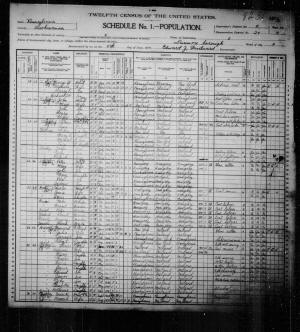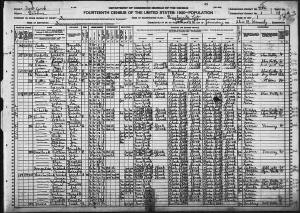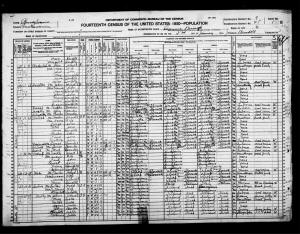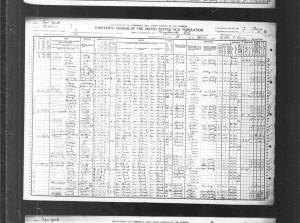| Slovakia Genealogy Research Strategies | ||||||
| Home | Strategy | Place Names | Churches | Census | History | Culture |
| TOOLBOX | Contents | Settlements | Maps | FHL Resources | Military | Correspondence |
| Library | Search | Dukla Pass | ||||
Seeking Genealogy Clues in the U.S. Census
Bill Tarkulich
May 21, 2005
Originally Published in New Rusyn Times, Carpatho-Rusyn Society, September, 2005
While many genealogy groups discuss the utility of the data contained in the US Census document, I’d like to begin a discussion here about how these data have been useful in our region of research.
Until now, I dismissed the usefulness of the US Census in my research, simply because I knew pretty much who and where all my relatives and immigrants are and where they came from. On a lark I decided one day to take a look at the data. Kathy Dorsam generously offered to do a few Ancestry.com lookups for me, since I didn’t see a value in paying money for the obvious. I was quite surprised at how much additional information over and above name, address and age were included. As I read the data, it begged further questions. I found myself becoming more interested in the sociological aspects of my family and their friends and found value in paying the fee. I found “boarders” living with my grandparents, some with the same family name but unknown to anyone living. Each incremental ten year period uncovered family movement and patterns which became quite interesting to follow. What started as a casual inquiry soon turned into another intriguing detective story.
What follows are observations I have made in my perusal of the U.S. Census, with a focus on the patterns of Rusyn Immigrants. While some of these are generalizations and some will be specific to my own investigations, I recognize that one size will never fit all. Each immigrant’s journey is unique. It is my intent to inspire and provide some different angles by which to approach your ancestral research.
IN GENERAL
Overall
1. Ancestry.com has really come a long ways in providing useful data. In particular, they have made available, for a fee, the 1930, 1920, 1910,1900,1890, and 1880 Federal Census, which capture the peak immigration period of our ancestors. The census is still not particularly “searchable.” I find their search engines to miss more than they find, even when using their “Best Matches (Ranked)” feature. However, they do provide images of the actual pages, which are extremely helpful in overcoming the lack of a reliable index.
2. A census is but a snapshot in time. It shows only one “day in a life.” You have to be careful not to read too far into it. Federal census occurred every ten years, and many things can happen over ten years.
Technical
1. As Rich Custer suggests, the quality and reporting of census data varies a great deal from decade to decade and taker to taker. Not only because of country changes, but it appears that enumerator education, training and understanding of those they were interviewing varied widely. Understanding of various ethnicities, and political makeup (Hungary, Czechoslovakia, Bohemia, etc.) of the time appear to be some of the largest issues. The inability to discriminate between Slovak, Magyar, Rusyn, Polish, Ukraine is legend. Was the individual truly illiterate? Or could they read and write in another language, but not in English?
Figure 1: 1900 Scranton-Dunmore - The typical census - everyone's from Hungary! |
2. Transcription quality (reading the handwritten census page and typing it into a computer database that can be searched) varies widely. The variance appears to be even greater than that which we see in the Ellis Island manifest transcriptions. The usual looks-like letter substitution strategy even fails me here, since it appears that certain of these Ancestry transcribers could not recognize old-style handwriting script.
Social
1. Based on the technical limitations described above, I found it nearly impossible to search for surnames using the Ancestry search tools. The search results most often missed finding entries for my surname, even when the entry was clearly written on the actual census page. What I resorted to was a geographical search: by city/town and neighborhood, which turned out to be quite productive and successful. To do this, I needed to know what city/town my ancestors lived it, or at least where I suspected they may have lived. While it was a challenge at first to determine the appropriate census “ward” and district, once I uncovered the correct volumes, paging through them yielded some delightful results.
If you’re unsure what neighborhood to start in, there’s always the church. Find the likely church your ancestors may have attended. While it sounds Herculean, most U.S. cities were much smaller than they are today. The amount of data will be far less than you may think. Since the data is columnar, I found it quite easy to scan quickly down the ethnicity or country columns looking for “Slovak”, or “Czechoslovakia” or “Hungary”. Our peoples have always been minorities and that can be used to a researcher’s advantage. You can quickly scan and discount the pages of Germans, Italians or any large ethnicity.
Be careful when paging through the census sequentially. Takers didn’t necessarily walk straight up and down one street. Various methodologies were used – One side of the street at a time was common. Another method I noted with particularly long streets, the taker went up and down a side street, then picked off one block of the major street on his/her way to the next side street. So when you see the street numbers “end” as you wouldn’t expect them to, look further along in the pages for numbering resume.
2. Immigrants tended to cluster together. I call this the “Sticky Hypothesis.” From the first arrivals in the late 1800s, until WW2, my immigrants clustered together for the obvious social benefits. Knowing this made my search infinitely easier, since you’ll often find many people “all in one place.” Often these same people were sponsors at christenings, or inspired marriages between families. An indirect method of research can be followed – If you cannot locate your ancestors, look for neighbors or people that your ancestors spoke of.
3. Since many of our ancestors seemed to live near each other, the job of deciphering the data was eased a bit by the good fortune that the same census taker usually handled most of the same neighborhood. That allows you to compensate for the failing of the taker’s understanding of ethnic characteristics, especially involving name spelling and poor penmanship; Once you decode one error, it tends to repeat itself and you solve a whole neighborhood’s problem.
The Data
The Census Data provides a bit more than the name, address and age that I had presumed. In fact, for genealogists, some very useful data are included.
1. Year of Immigration – useful to validate what you know from other documents, or use this to find that “missing manifest.”
2. Year of Naturalization – or not. Helps you know whether it’s worth looking for Naturalization data, or at least to estimate when naturalization may have occurred.
3. Age at marriage – Lets you back into a year of marriage, if you don’t already know. Once you know year of immigration and age of marriage, you can deduce whether they were married here or back in Europe.
4. Place of Birth – of the subject and that of their mother and father. Usually shown as a country name only, but this can be helpful.
Figure 2: 1920 Binghamton - Note the ambiguity of language and nation |
5. The spelling of the names during that era is always interesting. Were the surnames still using the old Magyar language constructs or the newer Slovak language or was it a phonetic English spelling? It always begs the question, “who was doing the spelling?” I found in one census, everyone was called by nicknames (Suzy, Mike) while in others, the given (formal) names were used.
6. Did they rent or own? How much was the house valued at? What did they pay for rent? Helps you to understand the economic circumstances of the times.
7. What type of job did they hold – Coal miner? Cigar Roller? Laborer in a foundry?
8. The nuclear family – Who was living in the house or apartment on that date? Had adult children moved out? Do you see small children that perhaps you heard about but died in their youth?
9. The extended family, “Boarders” – who else was living with this family or did they live alone? Most boarders before WWII were other family and friends in my research. It appears that the first-generation immigrants were very welcoming of having other villagers come and live with them. Were they living perhaps in a boarding house?
It’s interesting to compare the data given from census to census and see the variation or consistency. My grandfather listed three different years of immigration in three different census. It helps you understand better the nature of errors that are introduced. It’s also important to note that the more time that passes from the date of the event the more likely the information will be in error.
U.S. TOWN-SPECIFIC EXAMPLES
Based on the techniques above, combined with some grass-roots digging with city historians and immigrants who lived in particular locales, here are some specific observations regarding particular communities where Rusyns settled. My Rusyn immigrants were somewhat unique as they tended towards places that didn’t have huge Rusyn populations, but the observations are instructive nonetheless.
Corning, New York – Passenger manifests from about 1904 to 1909 indicate that dozens of my Rusyn relatives and their village-mates had gone to Corning. A 1905 city census confirmed dozens and dozens of Rusyns (I recognized all the names) were living a stones throw from the glass works in what must have been a boarding house. They were all single Rusyn men, most of them from villages not far from each other – Zboj, Ulic, Stuzycja, Nova Sedlica. Examining the 1900, 1910 and 1920 census found nearly none of these names earlier or remaining in Corning, nor any other Rusyns. Since many of my earlier immigrants had arrived early to Scranton, Pennsylvania, I can only conclude that this was an opportunistic, short term move. Perhaps the money or working conditions were better? When I explained this discovery to my Aunt, she expressed delight, since she always knew about her father’s friend from Corning that had never been discussed. She always wondered what the connection might be. I was pleased to find several of my Grandfather’s cousins had come to work in Corning. While the ship manifest indicated their final destination was Corning, the census confirmed it. But it appears that they all went back to Zboj, Ulic and Nova Sedlica within a few years. All except for my grandfather, who eventually moved to Rochester. The city historian was quite surprised to see this “cluster” of Rusyns, in a city where other ethnicities predominated. So don’t count only on Federal Census. Sometimes the local census can hold the data you need.
Scranton, Pennsylvania – Where many of my Rusyn immigrants initially settled. Again, this was another Rusyn minority. The population was quite small, with many comers and goers. Immigrants arrived as early as about 1895, mostly living on East Drinker Street, in the borough of Dunmore. *Watch your surname spelling as you track the years. The DZUBA family changed their surname to JUBA which made the search more challenging. *Watch your street name: The street names and building orientations also changed over the decades. On one census the house was on East Drinker, on the next the house was on Erie. Not because the street was renamed: it was on a corner lot, and they changed its orientation. Most of these Rusyn men worked in the coal mines. It turns out the coal they mined was literally beneath the city, so they had a short commute to work! In the 1930’s, a miner bored underneath the river which soon collapsed into the mines. This effectively ended mining in Scranton as the mine chambers were filled permanently with water.
Figure 3: 1920 Dunmore - unusually shows the actual village names |
Rochester, New York – Rochester had an extremely small Rusyn settlement. It’s unclear what attracted the Rusyns to Rochester – it appears that my Grandfather was probably the first to arrive, after living in Scranton, Corning, then spending short time in Binghamton and Syracuse. Perhaps a dozen Rusyn families at most, from a range of Rusyn villages. After WWI the area filled with ethnic Ukrainian immigrants. The Rusyns and Ukrainians went to the same church and socialized together mostly because their customs were similar and their numbers small.
I was always puzzled by one of my father’s baptismal sponsors, whom no one in the living family, including my father had ever heard of. While there was a record of Michael Ladomirak’s immigration (he came from the same village as my grandfather), there was no trace of a family or descendants. In 1920, I discovered he was living as a boarder in my Grandparent’s apartment right about the time my father was born. There was also another boarder also named Michael Tarkulich. This was likely another cousin who had lived with my grandfather in Corning about 1905. Small world! So the Ladomirak mystery was somewhat solved another mystery uncovered.
Watching my grandfather’s progression of jobs each decade was equally interesting – Foundry laborer, Metal works laborer, Blacksmith at a wheelwright’s shop. Most of those families tended to have similar jobs in similar factories. I was also able to find all of my Grandmother’s friends, streets they lived in and employment. However, this had to be done with a neighborhood review of each census page. The searchable index uncovered nearly none of the properly spelled surnames.
Another interesting Rochester phenomenon was the annexation of neighboring villages. My grandparents lived originally in the town of Gates, on streets that no longer exist. In the 19-teens Gates was annexed by the city of Rochester. Subsequent census showed them living at different street names, but the same house number. This led me to dig up some old maps of the city from the 1880s to the 1930s. Luckily for me the Rochester Public Library digitized these maps and put them on the web. In examination of the 1920s maps, I noticed the present-day street name along with what appeared to be the old name placed parenthetically. I was subsequently able to verify this was indeed the same place, different street name. The streets had all been renamed after annexation.
Binghamton, New York – This turned out to be a mother lode of Rusyn and Slovak immigrants, though little of it is related directly to my family. By 1910, I estimate there were between 2,000 and 3,000 Rusyns and Slovaks all living in the Clinton Street area. God graced this area with an excellent 1910 Census Enumerator named Walter E. Dewey. I will certainly be the first to nominate him for sainthood. He apparently had an rare understanding of ethnicities, nationalities and the current-day geo-politics. He was able to describe families quite accurately. He knew the difference between and documented languages of Magyar, Slovak, Ruthenian, and Bohemian. He documented place of birth as Hungary-Slovak, Russ-Polish, Hungary-Ruthenian, Austria-Moravia, Austria-German, and Austria-Polish. He did this on over 58 pages with 50 entries per page.
Figure 4: 1910 Binghamton - The detailed handiwork of Walter E Dewey note specificity of language and nation |
CONCLUSION
It should come as no surprise to most readers that our immigrant ancestors followed one another to their new country and likely settled near each other. We need to take this knowledge and use it when searching census records. With search engines failing us, we can still find these folks by looking in predictable neighborhoods. Living in close proximity, with little privacy was a lifestyle they grew up with and embraced in the new county. The records are there, it’s just figuring out how to dig it out that’s the challenge. Of course, this strategy falls to pieces within one generation. The drive to assimilate, the mobility of society, the western notion of independence and economic forces of post-World War II all took their toll on the cohesiveness of these early immigrant communities.
The key to immigrant research is to put yourself in their shoes. Try to think what they would have done and you are on your way to success.
We would be interested in hearing your research stories, discoveries and tribulations. Particular information about U.S. settlements would be appreciated.
Links to off-site webs will open in a new window. Please disable your pop-up stopper.
Last Update: 15 November 2020 Copyright © 2003-2021, Bill Tarkulich



